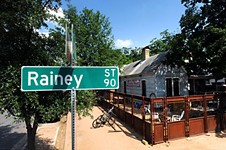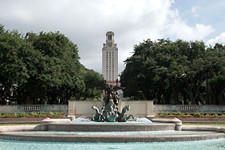Naked City
A New, Old Rainey Street?
By Kimberly Reeves, Fri., Aug. 6, 2004
The National Register listing, put in place in the late 1980s, has been the obstacle for most past plans to convert Rainey Street into part of the city's central business district. As Urban Design Officer Jana McCann told the Design Commission on Monday night, it's not as though the city can go back to the feds and "undo" the designation because they think they made some kind of mistake. The houses along Rainey Street are historic, regardless of how dilapidated they may become, or how many of their owners want to sell, or how many developers might want to develop along Town Lake.
The draft Rainey Street report suggests purchasing land to create an enclave of about a dozen of the most historic houses – either near the intersection of Rainey and Davis streets, or farther south near the planned Mexican-American Cultural Center. McCann freely admitted the enclave concept was neither the "highest nor best" method of preservation nor the "highest and best" use of the land, given the desire of most Rainey Street homeowners to sell.
"Our goal, in initiating this rezoning, is to come up with urban design standards so that redevelopment can happen in a graceful way," McCann said. "This is very much a compromise. We're trying to preserve the best of the historic homes and group them in a cluster that would make sense."
The plan proposes rezoning all Rainey property that isn't already zoned for Downtown use – CBD or DMU – to Commercial Services, or CS, which is less intense than what the Downtown Commission recommended. The zoning would also include tweaking the existing Waterfront Overlay District to increase setbacks and step-backs, limit surface parking, and minimize massing for new buildings that are taller than 120 feet. The plan also recommends widening Rainey and the adjacent streets and upgrading the infrastructure; connecting trails across the site; establishing a Park Impact Fee for new development; extending Red River Street in one of two directions; and finding a new public-private partnership to underwrite the cost of the Mexican-American Cultural Center.
The plan is not likely to draw praise from Chair Lisa Laky and the Historic Landmark Commission, which has fought vehemently to preserve the historic neighborhood. The plan will go to the HLC, the Planning Commission (which Riley also chairs), and back to the Downtown Commission before the end of the month.
Got something to say on the subject? Send a letter to the editor.










